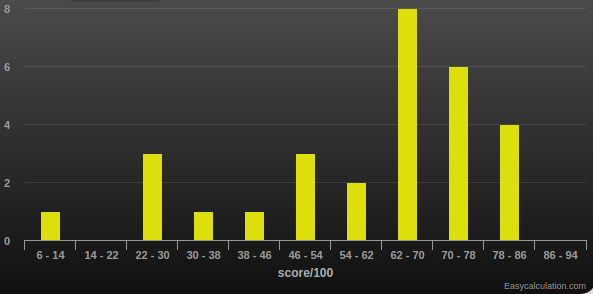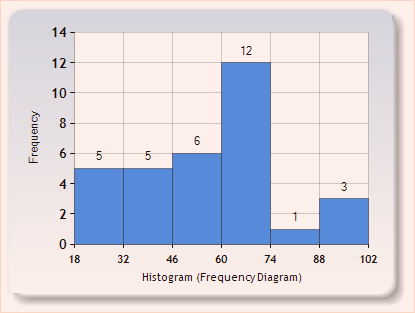Math 3340: Abstract Algebra
Prof. Allen Knutson
Grades: 70+ = A, 50-70 = B, 30-50 = C, 10-30 = D.
Score distribution:

Review session was in Malott 406 (opposite the library), Thursday 1-3 PM.
Book: Beachy and Blair, 3rd edition.
Grading: 25% HW (due Thursdays, in a pile up front at
the beginning of class), 25% midterm on March 23),
50% final on
Mon, May 22 2:00 PM in Malott 406.
Here are some practice problems for the final, with which you
can see the range of topics. (Of course you should also review
the ones from the homework!) I may have gone a little overboard
but do at least read them, and come to the review sessions with
a list of ones you want to hear about.
The midterm, with answers, is here.
Grades: 70+ = A, 50-70 = B, 30-50 = C.
Score distribution:

TA: Theodore Hui
OH: For me, Tuesday after class in 515 Malott. (It may take a
while to get there from class.)
You can also try the free-for-all on Mondays @12.
For Theodore, Tuesdays 3-5 PM, in 114 Malott.
On proofs:
As this is a 3000-level course, not everyone may come into the class
already knowing how to write and recognize proofs (and non-proofs),
but everyone should come out of it with these skills.
Prerequisites:
The principal prerequisites are some fluency with integer arithmetic
(e.g. congruences, and the fact that factorization into primes is unique,
even if you don't know how to prove that), and real familiarity
with linear algebra (e.g. you should get queasy when someone asserts
AB = BA without justification).
It's true in general math classes, but especially true at this level,
that they are language classes. Learning a language is hard,
and I am likely to use words in it (or more likely, notation) that I've
forgotten to define. Speak up and ask me what the notation means!
It's 106 times better that we (re)inforce the meaning
of some notation for a moment, than that you stew in confusion
until the next office hours. This is an important habit for math majors!
Answers to the homework questions are here
and here.
HW#1 due Thursday 2/2:
HW#2 due Thursday 2/9:
Hw#3 due Thursday 2/16:
HW#4 due Thursday 2/23:
[B & B] 2.2 #5,9. 3.1 #3,13,23. 3.2 #7
HW#5 due Thursday 2/30:
1. Let g be an element of a group G, and phi : G -> G be the function
taking h |-> h g h-1. In particular the image is
"the conjugacy class of g". (Note that this is not the map
g |-> h g h-1, in which h would be fixed and g varying,
though of course that thing's interesting too.)
a. Find all G,g for which this function is a group homomorphism.
(Prove you have the exact list.)
b. Find all G,g for which this function is 1:1. (Prove you have the
exact list.)
c. Find all G,g for which this function is onto. (Prove you have the
exact list.)
2. Same G,g,phi as above. Show there is a subgroup H such that phi
factors as G ->> G/H -> G, where the first map is the usual one, and
the second map is 1:1. (Neither are likely to be group homomorphisms.
Hint: figure out what this H must be.)
3. Use this to prove that the size of each conjugacy class divides #G.
4. Consider the equivalence relation generated by g ~ g-1,
and use it to prove that 2 | #G => there is some element of order 2.
5. Let G be abelian of even order.
a. Show that the map Q: G->G, g |-> g2, is not 1:1.
b. Show that the set H of elements of odd order is a subgroup.
c. Use Fermat's Little Theorem to
show that H is in the image of Q. [I was overthinking this.]
d. Show that for all sufficiently large powers n, Qn
has image H.
OPTIONAL. Figure out what Fermat's Little Theorem has to do
with anything here.
MYSTERY: I've had the dates wrong by a week on the above homeworks
since the beginning of the semester... and noone noticed it, and everyone's
turned in homework on the "right" day! I'd be more sorry about that,
except it apparently didn't matter to anyone.
HW #6 due 3/9: [BB] 3.8 # 5,6,9,13,17.
Compute the sizes of the conjugacy classes in S6; make sure
the numbers add up to 6!.
HW #7 due 3/16:
1. Consider 2x2 matrices of the form
a b
-3b a
where a,b are rational. Show that this set, with its usual (matrix)
addition and multiplication, is a field.
2. For p(x,y) a polynomial in x and y, define Rp as the polynomial
such that Rp(x,y) = p(y,x). For example if p = x^2 - xy, then Rp = y^2 - xy.
a. Show that R(pq) = (Rp)(Rq).
b. Use the division algorithm to show that p-Rp is a multiple of x-y.
Call this multiple Dp.
c. Show that DDp = 0.
3. Define (x choose n), where x is a letter and n is a natural number,
as x(x-1)(x-2)...(x-n+1)/n!. This is a polynomial in x with rational
coefficients.
a. Find and prove a formula for (-1 choose n).
b. Show that every polynomial in x of degree at most k is a
linear combination of the polynomials (x choose i) for i ranging
from 0 up to k.
HW #8 due 3/30:
[BB] 4.1 #2, 5, 6 (try p=2,3,5 to get the idea), 14. 4.2 #8, 9, 11
HW #9 due 4/13:
[BB] 5.1 #1,3,9,11, 5.2 #2,3,13, 5.3 #9,11,12
HW #10 due 4/20:
[BB] 4.3 #3,8,10,14, 5.4 #4,6,8,13
HW #11 due 5/4:
[BB] 6.1 #1,3,7, 6.2 #2,5, 6.5 #5
HW #12 due Tuesday 5/9:
[BB] 6.4 #1,5,14, 8.1 #2,6,7

